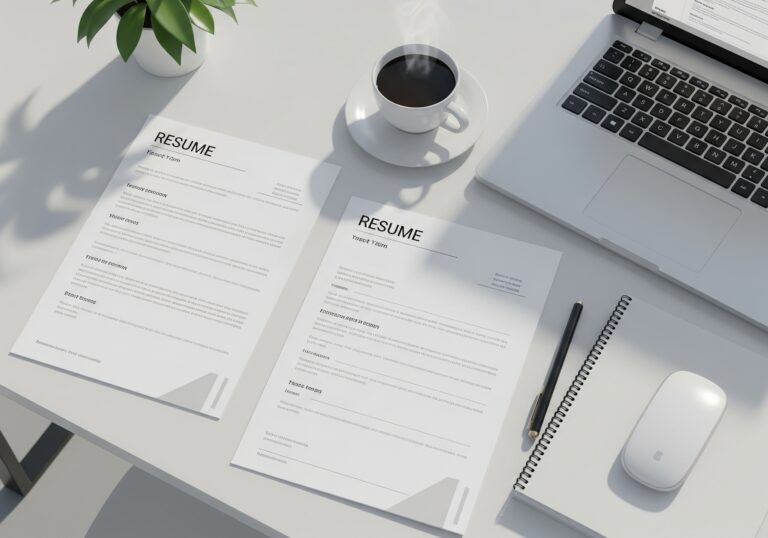How to Write a Resume That Gets You Interviews in 2025

Why Resumes Still Matter (Even in 2025)
Despite the rise of LinkedIn networking, AI screening tools, and video bios, resumes are still the #1 document hiring managers and recruiters rely on to make initial decisions. In fact, a recent report by CareerBuilder found that over 85% of hiring managers won’t even consider a candidate without one.
Your resume is your first impression — your pitch. It tells employers not just what you’ve done, but why they should care. When done right, it doesn’t just get read. It gets interviews. And in a competitive 2025 job market, that edge matters more than ever.
What Recruiters Actually Look For in 6 Seconds
Multiple eye-tracking studies show that recruiters skim resumes in just 6–8 seconds before making a “yes,” “no,” or “maybe” decision. What are they scanning for?
- Clear job title and summary that match the role they’re hiring for
- Relevant experience near the top (no digging required)
- Skills and certifications that align with the job description
- Readable layout with consistent formatting and spacing
If your resume doesn’t make an instant impact in those areas, it’s likely headed to the “no” pile — regardless of how strong your background is.
Resume Trends to Know for 2025
The resume landscape is changing — fast. Here are the biggest 2025 resume trends you need to adapt to if you want to stay competitive:
- Hybrid resumes: Combining functional and chronological formats for flexibility and clarity
- Keyword-rich summaries: Optimized for both ATS and human readers
- Clean design: Sans-serif fonts, no photos, subtle use of bold and spacing
- Metrics over tasks: “Increased client retention by 28%” beats “Managed customer service” every time
In short: your resume needs to be scannable, relevant, and modern — or it won’t even make it past the software, let alone the recruiter.
Step 1: Choose the Right Resume Format
In 2025, recruiters expect clean, professional formatting — and ATS software demands it. The top-performing format is the hybrid resume, which blends a reverse-chronological work history with a sectioned layout that highlights skills and results.
Avoid infographic-style resumes, columns, or PDF tricks that ATS systems can’t read. Stick to standard section headers like “Work Experience,” “Education,” and “Skills.” Use a single-column layout, bold for job titles, and bullet points to break up text for readability.
Step 2: Write a Summary That Sells You
Your resume summary (also called a professional summary or branding statement) should sit just below your name and contact info. In 2–4 lines, it should answer one question: Why should they interview you?
Use this formula: Job Title + Years of Experience + Niche/Industry + 1–2 Value Highlights. Example:
Senior Marketing Specialist with 6+ years of experience in SaaS and ecommerce. Known for driving 3x lead growth through content strategy and paid acquisition. Google Ads Certified.
Tailor your summary for each role using keywords from the job description. It’s not fluff — it’s your first opportunity to speak directly to the role and recruiter.
Step 3: Craft Powerful Bullet Points With Results
This is where most resumes fail. Listing tasks won’t get you hired. Show measurable impact using this bullet point formula:
Action verb + Task + Metric or Result
Good: “Managed social media channels”
Better: “Increased Instagram engagement by 42% through weekly Reels and audience polls”
Each bullet should start with a strong verb (e.g., led, designed, increased, implemented) and end with a clear outcome. Use numbers, percentages, timeframes — anything that shows scale or success.
Step 4: Use the Right Keywords for ATS
Over 95% of Fortune 500 companies use an Applicant Tracking System (ATS) to scan and rank resumes before a human ever sees them. If your resume doesn’t contain the right keywords, it may never reach a recruiter’s inbox — no matter how qualified you are.
To beat the bots, scan the job description for repeated phrases and required skills. These are your target keywords. Examples might include “project management,” “cross-functional collaboration,” or “Python programming.” Naturally weave these into your resume summary, work experience, and skills section — without keyword stuffing.
Step 5: Optimize Layout, Fonts, and Design
In 2025, clean design isn’t optional — it’s expected. Choose a simple, sans-serif font like Calibri, Helvetica, or Arial in 10–12pt size. Use bold headings, consistent spacing, and clear section breaks. Avoid graphics, text boxes, tables, or multiple columns — they confuse ATS software and clutter the reading experience.
Your layout should follow this order: Contact Info → Summary → Skills → Work Experience → Education → Certifications/Extras. Keep margins wide and use bullet points (not paragraphs) to enhance scannability. White space is your friend — it makes everything easier to absorb.
Step 6: Align Job Titles and Descriptions
One subtle way to increase relevance is to align your past job titles to the target role. For example, if your official title was “Customer Success Coordinator” but the job you’re applying for is a “Client Account Manager,” and your duties match, it’s okay to write: “Client Account Manager (Customer Success Coordinator).”
Then, use your bullet points to reinforce the overlap — especially with language pulled directly from the job ad. Tailoring isn’t just about content — it’s about semantics. Make it obvious you’re already doing the job they’re hiring for.
Step 7: Tailor Your Resume for Every Job Posting
One-size-fits-all resumes don’t work in 2025. Hiring managers can immediately tell when your application is generic. Tailoring doesn’t mean rewriting your resume from scratch — it means adjusting key elements to mirror the job description.
Update your summary, reorder skills, rephrase bullet points, and ensure the exact job title appears in your resume. Tools like Jobscan or Teal can help you compare your resume to the posting and highlight missing keywords. This small investment of time significantly boosts your interview chances.
Should You Include a Resume Objective in 2025?
In most cases, skip the resume objective. They’re outdated and often self-focused (e.g., “Seeking a role where I can grow my skills…”). Employers care less about your goals and more about how you solve their problems.
Instead, use a summary — it’s employer-focused, value-driven, and gives you space to insert keywords naturally. If you’re a recent graduate or making a major career pivot, you can include a short objective, but make it about what you bring to the table.
What to Cut: Fluff, Jargon, and Redundancy
A great resume is as much about what you remove as what you include. Cut:
- Outdated experience: Jobs from over 10 years ago (unless highly relevant)
- References available upon request: It’s assumed, not necessary
- Personal info: No need to include age, marital status, or full address
- Buzzwords without proof: “Go-getter” or “team player” means nothing without context
Each line should earn its place. If it doesn’t move the needle or support your case, cut it.
Mistakes That Will Get Your Resume Rejected
Even a strong resume can get tossed out due to small but critical mistakes. Avoid these resume killers in 2025:
- Spelling and grammar errors: Use Grammarly or a human proofreader
- Unprofessional email addresses: Stick to firstname.lastname@gmail.com
- Walls of text: Dense paragraphs get skipped, not read
- Inconsistent formatting: Mismatched fonts, indents, or bullet styles look sloppy
Take 15 minutes before sending to review your resume with fresh eyes — or even better, ask a trusted peer. One small mistake can make a bad first impression that’s hard to recover from.
Resume Checklist: Final Review Before You Submit
Use this quick checklist to ensure your resume is ready to go:
- Clear job title and summary
- Bullet points begin with action verbs
- Quantified results where possible
- Includes job-specific keywords
- One page (for under 10 years of experience)
- Saved as PDF (unless job post specifies Word)
Once it passes this test, you’re ready to hit submit with confidence.
FAQs About Writing a Resume That Gets Interviews
1. How long should a resume be in 2025?
One page is ideal for most professionals with under 10 years of experience. Two pages are acceptable for senior roles with extensive achievements.
2. Can I use a resume template?
Yes, but make sure it’s ATS-friendly: single column, standard fonts, and no graphics. Avoid Canva-style templates with multiple columns.
3. Do I need a different resume for every job?
You should tweak your resume for each job by adjusting keywords, titles, and skills to match the posting.
4. What’s better: a summary or an objective?
In 2025, a summary is better. It focuses on your value to the employer, while an objective is often vague and outdated.
5. How do I pass ATS filters?
Use exact phrases from the job description, keep your format simple, and avoid using tables, headers, or images.
Conclusion: From Resume to Interview — Your Next Step
In 2025, your resume is more than a document — it’s your personal marketing tool in a fast-moving, tech-driven hiring landscape. When optimized for both humans and ATS, a great resume becomes a magnet for interviews.
Apply the steps above, tailor your content, and avoid common mistakes. Whether you’re reentering the workforce, changing careers, or upgrading to a better opportunity, this guide gives you everything you need to get through the filters and get in the door.
To strengthen your job search and increase your chances of success, explore these next:






